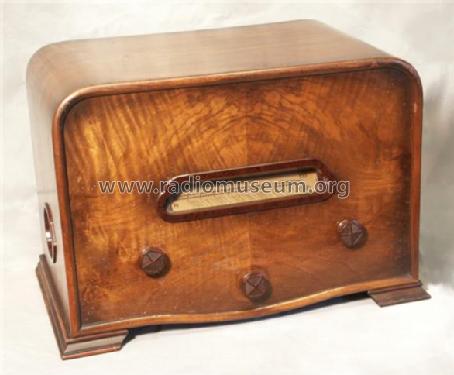Super Ondolina 533C1 220V
SBR Société Belge Radio-Electrique, Bruxelles
- Pays
- Belgique
- Fabricant / Marque
- SBR Société Belge Radio-Electrique, Bruxelles
- Année
- 1932/1933
- Catégorie
- Radio - ou tuner d'après la guerre 1939-45
- Radiomuseum.org ID
- 229120
- No. de tubes
- 5
- Principe général
- Super hétérodyne (en général); FI/IF 123 kHz; Détection par courbure d'anode.
- Circuits accordés
- 7 Circuits MA (AM)
- Gammes d'ondes
- PO et GO
- Tension / type courant
- Alimentation Courant Continu (CC) / 220 Volt
- Haut-parleur
- - Ce modèle nécessite des HP externes
- Matière
- Boitier en bois
- De Radiomuseum.org
- Modèle: Super Ondolina 533C1 [220V] - SBR Société Belge Radio-
- Forme
- Modèle de table boitier avec vouvercle
- Remarques
-
- This superheterodyne radio works on a simple wire antenna, where previous SBR superheterodyne models worked with a loop antenna.
- Tuning scales with names and wavelenghts are standard from now on.
- In the 110V DC version there are 2 output pentodes in parallel to compensate for the lower plate voltage, in the 220V DC version there is only 1 output pentode.
- The ballast tube is only for the filaments; the tubes are working on a higher plate voltage than the 110V DC version.
- SBR produced the following models 533:
- 533x1: table model without loudspeaker;
- 533x2: table model with loudspeaker;
- 533x3: luxury console;
- 533x4: luxury console with pick-up;
where 'x' represents 'A' (AC mains) or 'C' (DC mains, 110 or 220V)
- The "251_Ballast" current regulator (250mA; 60-180volt) can be replaced by any other brand of current regulator with the same or better specifications and the same foot (B4), like the Marconi "251_MOV" or the Philips "1934".
- Prix de mise sur le marché
- 2,700.00 BFr
- Auteur
- Modèle crée par Dirk Bladt. Voir les propositions de modification pour les contributeurs supplémentaires.
- D'autres Modèles
-
Vous pourrez trouver sous ce lien 733 modèles d'appareils, 680 avec des images et 416 avec des schémas.
Tous les appareils de SBR Société Belge Radio-Electrique, Bruxelles
